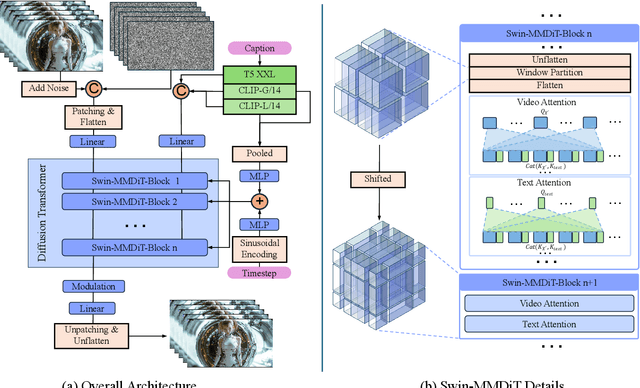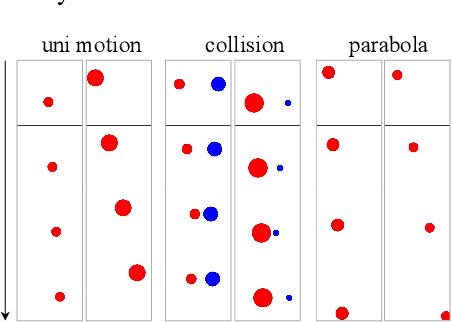Zhijie Lin
Seedance 1.0: Exploring the Boundaries of Video Generation Models
Jun 10, 2025Abstract:Notable breakthroughs in diffusion modeling have propelled rapid improvements in video generation, yet current foundational model still face critical challenges in simultaneously balancing prompt following, motion plausibility, and visual quality. In this report, we introduce Seedance 1.0, a high-performance and inference-efficient video foundation generation model that integrates several core technical improvements: (i) multi-source data curation augmented with precision and meaningful video captioning, enabling comprehensive learning across diverse scenarios; (ii) an efficient architecture design with proposed training paradigm, which allows for natively supporting multi-shot generation and jointly learning of both text-to-video and image-to-video tasks. (iii) carefully-optimized post-training approaches leveraging fine-grained supervised fine-tuning, and video-specific RLHF with multi-dimensional reward mechanisms for comprehensive performance improvements; (iv) excellent model acceleration achieving ~10x inference speedup through multi-stage distillation strategies and system-level optimizations. Seedance 1.0 can generate a 5-second video at 1080p resolution only with 41.4 seconds (NVIDIA-L20). Compared to state-of-the-art video generation models, Seedance 1.0 stands out with high-quality and fast video generation having superior spatiotemporal fluidity with structural stability, precise instruction adherence in complex multi-subject contexts, native multi-shot narrative coherence with consistent subject representation.
SeedVR2: One-Step Video Restoration via Diffusion Adversarial Post-Training
Jun 05, 2025Abstract:Recent advances in diffusion-based video restoration (VR) demonstrate significant improvement in visual quality, yet yield a prohibitive computational cost during inference. While several distillation-based approaches have exhibited the potential of one-step image restoration, extending existing approaches to VR remains challenging and underexplored, particularly when dealing with high-resolution video in real-world settings. In this work, we propose a one-step diffusion-based VR model, termed as SeedVR2, which performs adversarial VR training against real data. To handle the challenging high-resolution VR within a single step, we introduce several enhancements to both model architecture and training procedures. Specifically, an adaptive window attention mechanism is proposed, where the window size is dynamically adjusted to fit the output resolutions, avoiding window inconsistency observed under high-resolution VR using window attention with a predefined window size. To stabilize and improve the adversarial post-training towards VR, we further verify the effectiveness of a series of losses, including a proposed feature matching loss without significantly sacrificing training efficiency. Extensive experiments show that SeedVR2 can achieve comparable or even better performance compared with existing VR approaches in a single step.
Seaweed-7B: Cost-Effective Training of Video Generation Foundation Model
Apr 11, 2025Abstract:This technical report presents a cost-efficient strategy for training a video generation foundation model. We present a mid-sized research model with approximately 7 billion parameters (7B) called Seaweed-7B trained from scratch using 665,000 H100 GPU hours. Despite being trained with moderate computational resources, Seaweed-7B demonstrates highly competitive performance compared to contemporary video generation models of much larger size. Design choices are especially crucial in a resource-constrained setting. This technical report highlights the key design decisions that enhance the performance of the medium-sized diffusion model. Empirically, we make two observations: (1) Seaweed-7B achieves performance comparable to, or even surpasses, larger models trained on substantially greater GPU resources, and (2) our model, which exhibits strong generalization ability, can be effectively adapted across a wide range of downstream applications either by lightweight fine-tuning or continue training. See the project page at https://seaweed.video/
Bridging Continuous and Discrete Tokens for Autoregressive Visual Generation
Mar 20, 2025Abstract:Autoregressive visual generation models typically rely on tokenizers to compress images into tokens that can be predicted sequentially. A fundamental dilemma exists in token representation: discrete tokens enable straightforward modeling with standard cross-entropy loss, but suffer from information loss and tokenizer training instability; continuous tokens better preserve visual details, but require complex distribution modeling, complicating the generation pipeline. In this paper, we propose TokenBridge, which bridges this gap by maintaining the strong representation capacity of continuous tokens while preserving the modeling simplicity of discrete tokens. To achieve this, we decouple discretization from the tokenizer training process through post-training quantization that directly obtains discrete tokens from continuous representations. Specifically, we introduce a dimension-wise quantization strategy that independently discretizes each feature dimension, paired with a lightweight autoregressive prediction mechanism that efficiently model the resulting large token space. Extensive experiments show that our approach achieves reconstruction and generation quality on par with continuous methods while using standard categorical prediction. This work demonstrates that bridging discrete and continuous paradigms can effectively harness the strengths of both approaches, providing a promising direction for high-quality visual generation with simple autoregressive modeling. Project page: https://yuqingwang1029.github.io/TokenBridge.
Long Context Tuning for Video Generation
Mar 13, 2025Abstract:Recent advances in video generation can produce realistic, minute-long single-shot videos with scalable diffusion transformers. However, real-world narrative videos require multi-shot scenes with visual and dynamic consistency across shots. In this work, we introduce Long Context Tuning (LCT), a training paradigm that expands the context window of pre-trained single-shot video diffusion models to learn scene-level consistency directly from data. Our method expands full attention mechanisms from individual shots to encompass all shots within a scene, incorporating interleaved 3D position embedding and an asynchronous noise strategy, enabling both joint and auto-regressive shot generation without additional parameters. Models with bidirectional attention after LCT can further be fine-tuned with context-causal attention, facilitating auto-regressive generation with efficient KV-cache. Experiments demonstrate single-shot models after LCT can produce coherent multi-shot scenes and exhibit emerging capabilities, including compositional generation and interactive shot extension, paving the way for more practical visual content creation. See https://guoyww.github.io/projects/long-context-video/ for more details.
SeedVR: Seeding Infinity in Diffusion Transformer Towards Generic Video Restoration
Jan 04, 2025



Abstract:Video restoration poses non-trivial challenges in maintaining fidelity while recovering temporally consistent details from unknown degradations in the wild. Despite recent advances in diffusion-based restoration, these methods often face limitations in generation capability and sampling efficiency. In this work, we present SeedVR, a diffusion transformer designed to handle real-world video restoration with arbitrary length and resolution. The core design of SeedVR lies in the shifted window attention that facilitates effective restoration on long video sequences. SeedVR further supports variable-sized windows near the boundary of both spatial and temporal dimensions, overcoming the resolution constraints of traditional window attention. Equipped with contemporary practices, including causal video autoencoder, mixed image and video training, and progressive training, SeedVR achieves highly-competitive performance on both synthetic and real-world benchmarks, as well as AI-generated videos. Extensive experiments demonstrate SeedVR's superiority over existing methods for generic video restoration.
Parallelized Autoregressive Visual Generation
Dec 19, 2024



Abstract:Autoregressive models have emerged as a powerful approach for visual generation but suffer from slow inference speed due to their sequential token-by-token prediction process. In this paper, we propose a simple yet effective approach for parallelized autoregressive visual generation that improves generation efficiency while preserving the advantages of autoregressive modeling. Our key insight is that parallel generation depends on visual token dependencies-tokens with weak dependencies can be generated in parallel, while strongly dependent adjacent tokens are difficult to generate together, as their independent sampling may lead to inconsistencies. Based on this observation, we develop a parallel generation strategy that generates distant tokens with weak dependencies in parallel while maintaining sequential generation for strongly dependent local tokens. Our approach can be seamlessly integrated into standard autoregressive models without modifying the architecture or tokenizer. Experiments on ImageNet and UCF-101 demonstrate that our method achieves a 3.6x speedup with comparable quality and up to 9.5x speedup with minimal quality degradation across both image and video generation tasks. We hope this work will inspire future research in efficient visual generation and unified autoregressive modeling. Project page: https://epiphqny.github.io/PAR-project.
How Far is Video Generation from World Model: A Physical Law Perspective
Nov 04, 2024



Abstract:OpenAI's Sora highlights the potential of video generation for developing world models that adhere to fundamental physical laws. However, the ability of video generation models to discover such laws purely from visual data without human priors can be questioned. A world model learning the true law should give predictions robust to nuances and correctly extrapolate on unseen scenarios. In this work, we evaluate across three key scenarios: in-distribution, out-of-distribution, and combinatorial generalization. We developed a 2D simulation testbed for object movement and collisions to generate videos deterministically governed by one or more classical mechanics laws. This provides an unlimited supply of data for large-scale experimentation and enables quantitative evaluation of whether the generated videos adhere to physical laws. We trained diffusion-based video generation models to predict object movements based on initial frames. Our scaling experiments show perfect generalization within the distribution, measurable scaling behavior for combinatorial generalization, but failure in out-of-distribution scenarios. Further experiments reveal two key insights about the generalization mechanisms of these models: (1) the models fail to abstract general physical rules and instead exhibit "case-based" generalization behavior, i.e., mimicking the closest training example; (2) when generalizing to new cases, models are observed to prioritize different factors when referencing training data: color > size > velocity > shape. Our study suggests that scaling alone is insufficient for video generation models to uncover fundamental physical laws, despite its role in Sora's broader success. See our project page at https://phyworld.github.io
LVD-2M: A Long-take Video Dataset with Temporally Dense Captions
Oct 14, 2024



Abstract:The efficacy of video generation models heavily depends on the quality of their training datasets. Most previous video generation models are trained on short video clips, while recently there has been increasing interest in training long video generation models directly on longer videos. However, the lack of such high-quality long videos impedes the advancement of long video generation. To promote research in long video generation, we desire a new dataset with four key features essential for training long video generation models: (1) long videos covering at least 10 seconds, (2) long-take videos without cuts, (3) large motion and diverse contents, and (4) temporally dense captions. To achieve this, we introduce a new pipeline for selecting high-quality long-take videos and generating temporally dense captions. Specifically, we define a set of metrics to quantitatively assess video quality including scene cuts, dynamic degrees, and semantic-level quality, enabling us to filter high-quality long-take videos from a large amount of source videos. Subsequently, we develop a hierarchical video captioning pipeline to annotate long videos with temporally-dense captions. With this pipeline, we curate the first long-take video dataset, LVD-2M, comprising 2 million long-take videos, each covering more than 10 seconds and annotated with temporally dense captions. We further validate the effectiveness of LVD-2M by fine-tuning video generation models to generate long videos with dynamic motions. We believe our work will significantly contribute to future research in long video generation.
Loong: Generating Minute-level Long Videos with Autoregressive Language Models
Oct 03, 2024



Abstract:It is desirable but challenging to generate content-rich long videos in the scale of minutes. Autoregressive large language models (LLMs) have achieved great success in generating coherent and long sequences of tokens in the domain of natural language processing, while the exploration of autoregressive LLMs for video generation is limited to generating short videos of several seconds. In this work, we conduct a deep analysis of the challenges that prevent autoregressive LLM-based video generators from generating long videos. Based on the observations and analysis, we propose Loong, a new autoregressive LLM-based video generator that can generate minute-long videos. Specifically, we model the text tokens and video tokens as a unified sequence for autoregressive LLMs and train the model from scratch. We propose progressive short-to-long training with a loss re-weighting scheme to mitigate the loss imbalance problem for long video training. We further investigate inference strategies, including video token re-encoding and sampling strategies, to diminish error accumulation during inference. Our proposed Loong can be trained on 10-second videos and be extended to generate minute-level long videos conditioned on text prompts, as demonstrated by the results. More samples are available at: https://epiphqny.github.io/Loong-video.
 Add to Chrome
Add to Chrome Add to Firefox
Add to Firefox Add to Edge
Add to Edge